
An audio power amplifier amplifies low-power electronic audio signals, such as the signal from a radio receiver or an electric guitar pickup, to a level that is high enough for driving loudspeakers or headphones. Audio power amplifiers are found in all manner of sound systems including sound reinforcement, public address, home audio systems and musical instrument amplifiers like guitar amplifiers. It is the final electronic stage in a typical audio playback chain before the signal is sent to the loudspeakers.

Vox is a British musical equipment manufacturer founded in 1957 by Thomas Walter Jennings in Dartford, Kent, England. The company is most famous for making the Vox AC30 guitar amplifier, used by The Beatles, The Rolling Stones, The Kinks, The Yardbirds, Queen, Dire Straits, U2, and Radiohead; the Vox Continental electric organ, the Vox wah-wah pedal used by Jimi Hendrix, and a series of innovative electric guitars and bass guitars. Since 1992, Vox has been owned by the Japanese electronics firm Korg.

An instrument amplifier is an electronic device that converts the often barely audible or purely electronic signal of a musical instrument into a larger electronic signal to feed to a loudspeaker. An instrument amplifier is used with musical instruments such as an electric guitar, an electric bass, electric organ, electric piano, synthesizers and drum machine to convert the signal from the pickup or other sound source into an electronic signal that has enough power, due to being routed through a power amplifier, capable of driving one or more loudspeaker that can be heard by the performers and audience.

A guitar amplifier is an electronic device or system that strengthens the electrical signal from a pickup on an electric guitar, bass guitar, or acoustic guitar so that it can produce sound through one or more loudspeakers, which are typically housed in a wooden cabinet. A guitar amplifier may be a standalone wood or metal cabinet that contains only the power amplifier circuits, requiring the use of a separate speaker cabinet–or it may be a "combo" amplifier, which contains both the amplifier and one or more speakers in a wooden cabinet. There is a wide range of sizes and power ratings for guitar amplifiers, from small, lightweight "practice amplifiers" with a single 6-inch speaker and a 10-watt amp to heavy combo amps with four 10-inch or four 12-inch speakers and a 100-watt amplifier, which are loud enough to use in a nightclub or bar performance.

The Roland Bolt 30/60/100 was the only line of tube guitar amplifiers produced by Roland. The Bolt amplifier series was released in 1979.

A bass amplifier is a musical instrument electronic device that uses electrical power to make lower-pitched instruments such as the bass guitar or double bass loud enough to be heard by the performers and audience. Bass amps typically consist of a preamplifier, tone controls, a power amplifier and one or more loudspeakers ("drivers") in a cabinet.

The Fender Twin and Twin Reverb are guitar amplifiers made by Fender Musical Instruments Corporation. The Twin was introduced in 1952, two years before Fender began selling Stratocaster electric guitars. The amps are known for their characteristically clean tone.
AHED was a Canadian company owned by Phil G. Anderson that produced guitar amplifiers, as well as guitars. Its main product line was the GBX amplifier, which could reach 180 watts with 4x10", 4x12" or 2x15" speakers. The GBX amplifier had a pre-amplifier that could change the gain, brilliance, depth, contour and response of the output.

The Fender Hot Rod Deluxe is a guitar amplifier manufactured and sold by the Fender Musical Instruments Corporation. It was introduced in 1996 as part of the "Hot Rod" line of guitar amplifiers and has been in continuous production since. The Hot Rod Deluxe is a modified version of the Fender Blues Deluxe from the earlier Blues line of amplifiers, and has a higher level of gain in its preamplification signal. This model, along with the Hot Rod Deville, were originally designated as F.A.T. amplifiers but this moniker was dropped in 2002 when production of this series of amps was moved from Corona, CA to Fender's Baja-Ensenada, Mexico manufacturing facility.

The Fender Bassman is a series of bass amplifiers introduced by Fender during 1952. Initially intended to amplify bass guitars, musicians used the 5B6 Bassman to amplify other instruments, including electric guitars, harmonicas, and pedal steel guitars. Besides being a popular and important amplifier in its own right, the Bassman also became the foundation on which Marshall and other companies built their high-gain tube amplifiers.

The Fender Super Reverb is a guitar amplifier made by Fender. It was originally introduced in 1963 and was discontinued in 1982. The Super Reverb was a Fender Super amplifier with built-in reverb and "vibrato". The original Super Reverb amplifiers were all-tube designs and featured spring reverb. There were two different designs, distinguishable by the color of the "face" or front control panel. Super Reverbs from 1963 through 1967 had "blackface" panels. From 1968 until its discontinuation in 1982, the Super Reverb had "silverface" cosmetics and circuitry. Early models in 1968, while cosmetically "silverface", did contain "blackface" circuitry. Fender introduced a reissue '65 Super Reverb in 2001 featuring a printed circuit board design rather than the hand-wired circuitry of the original '65 Super Reverb.
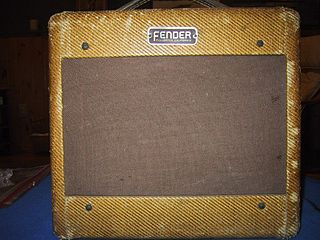
The Fender Champ was a guitar amplifier made by Fender. It was introduced in 1948 and discontinued in 1982. An updated version was introduced in 2006 as part of the "Vintage Modified" line.

Trace Elliot is a United Kingdom-based bass amplification manufacturer, and has a sub-brand, Trace Acoustic, for acoustic instruments.
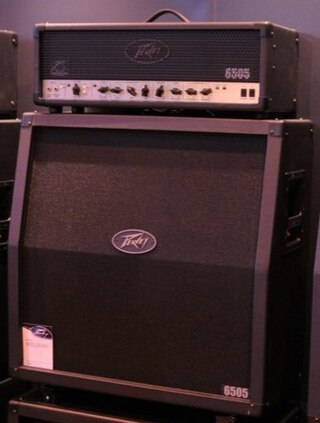
The Peavey 5150 is a vacuum tube based guitar amplifier made by Peavey Electronics from 1992 on. The amplifier was initially created as a signature model for Eddie Van Halen. After Van Halen and Peavey parted ways in 2004, the name was changed to Peavey 6505 in celebration of Peavey's 40th anniversary (1965–2005). The 5150 name was used again by Van Halen in partnership with Fender under the EVH brand in 2007 and 2011.
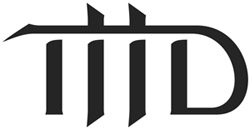
THD Electronics, Ltd. is a manufacturer of amplifier accessories, and a former manufacturer of vacuum-tube guitar amplifiers. It is located in Seattle, Washington. It was founded in 1986 by President and CEO Andrew Marshall. At one time specializing in hand-built, vacuum tube “boutique”-style amplifiers, it continues to manufacture the “world’s best selling [guitar amplifier] power attenuator,” the THD Hot Plate. The company is well known in the boutique amplifier market, and is often credited with the creation of this market in the United States. THD's line of products stayed relatively small despite its 22-year history as a company. Of its amplifiers, THD made three: the UniValve, BiValve-30, and Flexi-50.
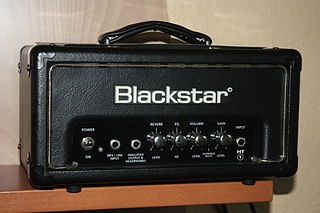
Blackstar Amplification is a British company that produces and manufacturers guitar amplifiers and effects units. The company was founded by a group of ex-Marshall employees, most notably Bruce Keir, who became technical Director at Blackstar, and former Chief Design Engineer at Marshall, Ian Robinson. In 2009 the company began operations in the United States. The majority of the research and development for Blackstar is carried out in the UK. Blackstar is endorsed by major artists like Ozzy Osbourne, Neal Schon, Opeth, and Richie Sambora of Bon Jovi. Blackstar has been consistently ranked amongst the best amplification brands by leading guitarists. Bruce Keir died in September 2021 at the age of 60.
Fryette Amplification of North Hollywood, California is a manufacturer of hand-built electric guitar amplifiers, speaker cabinets, power amplifiers, sound effects pedals and pedalboard accessories. The company was founded as VHT Amplification in Studio City, Los Angeles, California by Steven Fryette in January 1989 and was the first to produce a true three-channel vacuum tube amplifier.
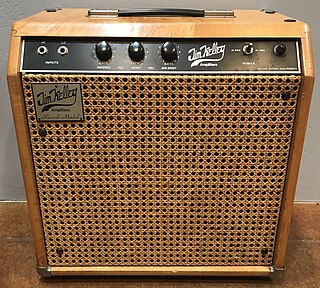
Jim Kelley Amplifiers is the trademark for the vacuum tube guitar amplifiers designed by Jim Kelley and manufactured by his company Active Guitar Electronics of Tustin, California between the years of 1978 and 1985. Approximately 600 of these amps were built during that time. The single-channel version of the amplifier employed modest gain in the preamp stages, Baxandall type bass and treble controls, a split load phase inverter, and four 6V6GT output tubes. The amplifiers produce 60 watts RMS at full power, and include a half power (30/60) switch.

Traynor is a brand of bass amplifiers and guitar amplifiers, the first brand formed by Yorkville Sound. The Traynor brand, named for founder Peter Traynor, began in 1963 with the Dynabass bass amplifier, a rental product. Traynor first became popular in Canada by providing less expensive versions of the circuits used in Marshall and Fender amplifiers of the time. The revived brand now produces a wide range of electric, acoustic, and bass guitar amps.
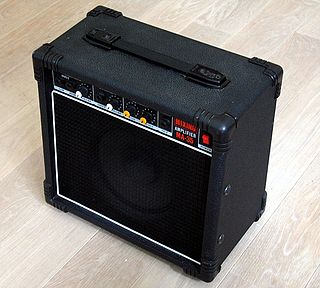
A keyboard amplifier is a powered electronic amplifier and loudspeaker in a wooden speaker cabinet used for the amplification of electronic keyboard instruments. Keyboard amplifiers are distinct from other types of amplification systems such as guitar amplifiers due to the particular challenges associated with making keyboards sound louder on stage; namely, to provide solid low-frequency sound reproduction for the deep basslines that keyboards can play and crisp high-frequency sound for the high-register notes. Another difference between keyboard amplifiers and guitar/bass amplifiers is that keyboard amps are usually designed with a relatively flat frequency response and low distortion. In contrast, many guitar and bass amp designers purposely make their amplifiers modify the frequency response, typically to "roll-off" very high frequencies, and most rock and blues guitar amps, and since the 1980s and 1990s, even many bass amps are designed to add distortion or overdrive to the instrument tone.




















